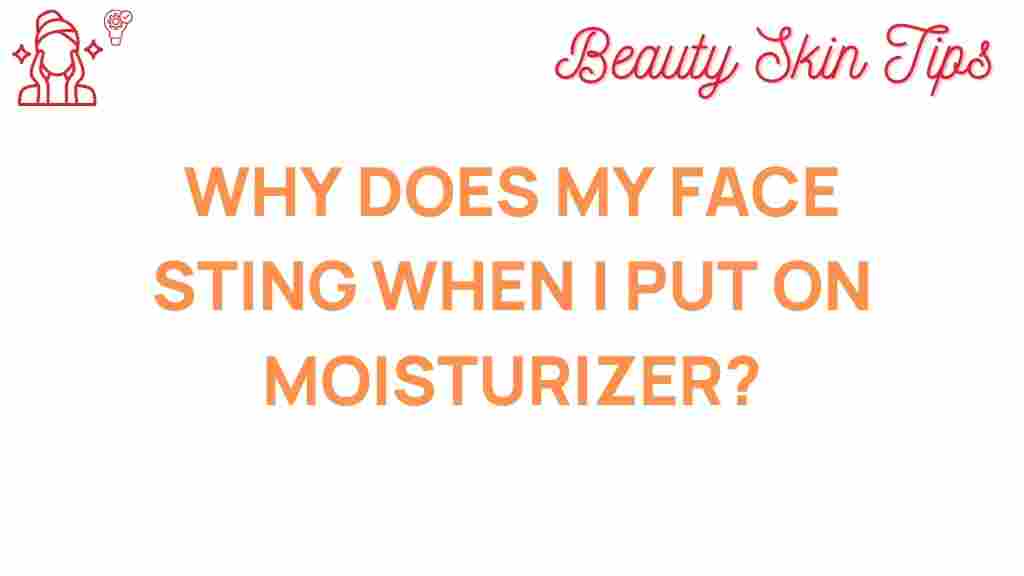The Mystery Behind Facial Stinging: What Your Moisturizer Might Be Hiding
Facial stinging is a common yet often overlooked issue that many individuals experience in their skincare journey. Whether you’re applying a new moisturizer or sticking to your tried-and-true favorites, that sudden tingling sensation can lead to questions about what’s actually happening to your skin. Understanding the underlying causes of facial stinging is crucial for achieving healthy skin and making informed choices about the products you use. In this article, we will delve into the mysteries behind facial stinging, what your moisturizer might be hiding, and how you can address this discomfort.
Understanding Facial Stinging
Facial stinging can manifest as a mild to intense burning sensation on the skin. It can occur immediately after applying a product or develop gradually over time. To properly address the issue, it’s important to know the common causes that lead to this uncomfortable sensation.
Common Causes of Facial Stinging
- Active Ingredients: Many moisturizers contain potent active ingredients such as acids (AHAs, BHAs), retinoids, or vitamin C, which can cause temporary stinging, especially for sensitive skin.
- Preservatives and Fragrances: Some products contain synthetic fragrances and preservatives that may irritate the skin, leading to a stinging sensation.
- Skin Conditions: Conditions like eczema, rosacea, or allergies can make the skin more sensitive, increasing the likelihood of facial stinging.
- pH Levels: A product with an improper pH level can disrupt your skin’s barrier, causing irritation and stinging.
- Skin Type: Individuals with sensitive skin are more prone to experiencing facial stinging in reaction to certain ingredients.
Identifying the Problematic Ingredients in Your Moisturizer
To effectively combat facial stinging, it’s essential to identify the ingredients in your moisturizer that may be causing the irritation. Follow this step-by-step process to analyze your products:
Step 1: Read the Ingredient List
Start by carefully reviewing the ingredient label on your moisturizer. Ingredients are usually listed in descending order of their concentration. Look for:
- Active ingredients (e.g., acids, retinol)
- Fragrances (both synthetic and natural)
- Preservatives (such as parabens or formaldehyde)
Step 2: Research Each Ingredient
Use reliable sources to research any unfamiliar ingredients. Websites such as INCI Decoder provide detailed information about cosmetic ingredients and their potential effects on the skin.
Step 3: Patch Test New Products
Before fully incorporating a new moisturizer into your routine, perform a patch test. Apply a small amount of the product to a discreet area of skin, such as behind your ear or on your wrist, and observe for any adverse reactions over 24 hours.
Troubleshooting Facial Stinging
If you experience facial stinging, it’s important to troubleshoot the issue effectively. Here are some tips to help you address and minimize discomfort:
Tip 1: Stop Using the Product
The first and most straightforward step is to discontinue use of the product that caused the stinging. This will allow your skin to recover and prevent further irritation.
Tip 2: Opt for Gentle Formulations
Switch to moisturizers specifically designed for sensitive skin. Look for products that are:
- Fragrance-free
- Alcohol-free
- Hypoallergenic
Tip 3: Incorporate Soothing Ingredients
Look for soothing ingredients in your moisturizer, such as:
- Aloe Vera
- Ceramides
- Chamomile
- Green Tea Extract
Tip 4: Adjust Your Routine
If you’re using multiple active ingredients, consider simplifying your skincare routine. Overloading your skin can lead to irritation. Gradually introduce new products to give your skin time to adjust.
Tip 5: Consult a Dermatologist
If facial stinging persists despite making adjustments, consult a dermatologist. They can help identify underlying skin issues and recommend suitable products tailored to your skin type.
When to Seek Professional Help
While facial stinging can be a benign reaction to certain ingredients, there are times when it may indicate a more serious skin concern. Seek professional help if:
- Stinging is accompanied by swelling, redness, or hives.
- You notice a rash that does not improve with time.
- Over-the-counter treatments do not alleviate your symptoms.
Conclusion
Facial stinging can be an alarming experience that detracts from your skincare routine. By understanding the potential causes and how to troubleshoot them, you can take proactive steps to protect your skin. Always pay attention to the ingredient list, perform patch tests, and choose products wisely to minimize irritation. Remember that everyone’s skin is unique, so what works for one person may not work for another. Don’t hesitate to seek professional advice if needed; your skin deserves the best!
For more information on skincare ingredients and their effects, visit our skincare resource page.
This article is in the category Skincare and created by BeautySkinTips Team
